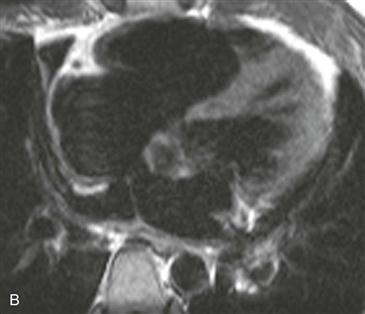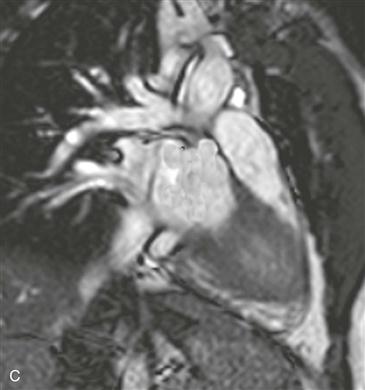CASE 127



1. What are causes of pulmonary edema? (Choose all that apply.)
2. What is the finding in the left atrium?
B. Pedunculated mass arising from the septum
C. Fat infiltration of the septum
B. Myxoma
D. Angiosarcoma
4. How is this condition managed when it is discovered in the neonatal period?
ANSWERS
References
Holloway BJ, Agarwal PP. Incidental cor triatriatum discovered on multidetector computed tomography. J Thorac Imaging. 2011;26(2):W45–W47.
Krasemann Z, Scheld HH, Tjan TD, et al. Cor triatriatum: short review of the literature upon ten new cases. Herz. 2007;32(6):506–510.
Su CS, Tsai IC, Lin WW, et al. Usefulness of multidetector-row computed tomography in evaluating adult cor triatriatum. Tex Heart Inst J. 2008;35(3):349–351.
Cross-Reference
Cardiac Imaging: The REQUISITES, ed 3, pp 190–191.
Comment
Imaging
Cine steady-state free precession (SSFP) and black blood four-chamber images show a thin membrane in the posterior left atrium extending to the interatrial septum. The membrane divides the atrium into two chambers separating the right from the left pulmonary venous inflow (Figs. A and B).
Description
Cor triatriatum, also known as the triatrial heart, is a congenital heart defect characterized by a thin membrane dividing either the right or the left atrium. In most patients, either single or multiple fenestrations within the membrane allow unimpeded blood flow. In adults, the fenestration is often large, and the heart defect is of little or no clinical significance and rarely causes symptoms. When the defect causes symptoms, it mimics the clinical presentation of mitral stenosis. In infants and children, the fenestration is often small or absent, leading to dyspnea, failure to thrive, and cyanosis.
Diagnosis
Cor triatriatum is most commonly diagnosed with echocardiography; transesophageal echocardiography is more sensitive than transthoracic echocardiography. This entity is increasingly being diagnosed with the aid of CT or MRI. These modalities also aid in diagnosis of other associated congenital heart defects. Cine SSFP MRI is helpful in assessing for turbulent flow through the fenestration as a marker of flow disturbance.
Significance in Adults
Cor triatriatum is an incidental finding of no consequence if the fenestration is large and discovered in adults. Cor triatriatum in infants and children is surgically corrected when the fenestration is small or absent. Patient prognosis is excellent if there are no coexisting heart defects.







